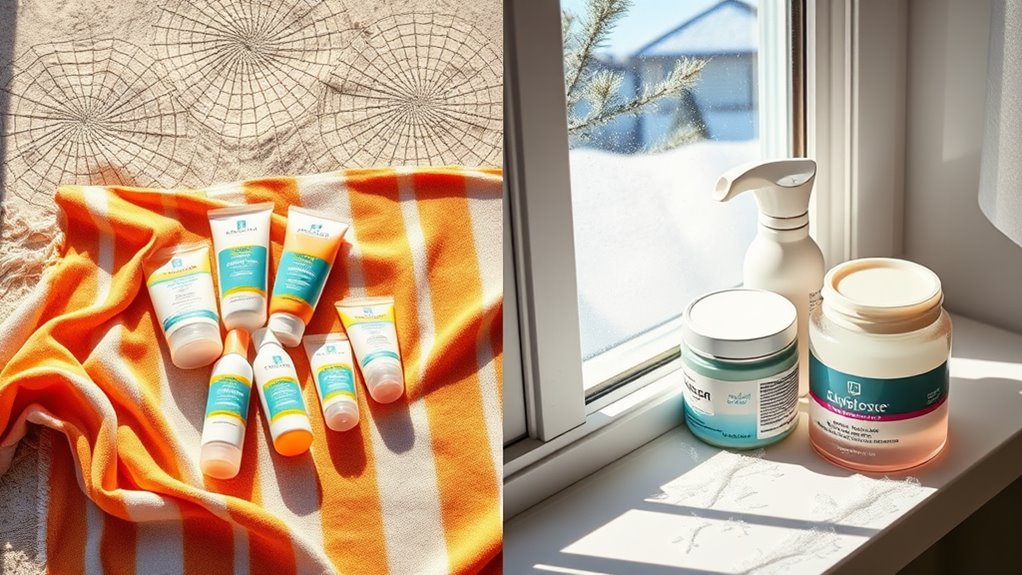How to Finally Master Summer vs. Winter Skincare (Without Overthinking It)
You’ll master summer versus winter skincare by adapting your routine to seasonal shifts—opting for lightweight, SPF-packed formulas in summer to shield against UV and humidity, while choosing rich, ceramide-infused barriers in winter to lock in moisture and fend off dry winds. Keep it simple by monitoring your skin’s pH and testing products first. Dive into the essentials ahead for a foolproof, year-round glow.
Key Takeaways
- Adjust your routine for summer by prioritizing lightweight hydration and broad-spectrum SPF to combat UV and humidity.
- Switch to winter essentials like ceramide-rich moisturizers and occlusives to protect against dryness and cold winds.
- Simplify transitions by patch-testing products and focusing on key changes rather than overhauling everything.
- Use multi-tasking items, such as serums with hyaluronic acid, to handle seasonal needs without adding complexity.
- Monitor your skin’s response every few weeks and stick to basics for a balanced, stress-free skincare approach.
Key Differences in Seasonal Skincare
As seasons shift, you’ll notice your skin demands different care to combat varying environmental stresses. This is due to changes in UV exposure that can significantly influence skin health and appearance.
In summer vs. winter skincare, environmental factors drive key differences. Summer’s high UV exposure and humidity accelerate oil production and dehydration, making you prioritize sun protection and lightweight hydration to prevent damage. You must actively adapt by reducing heavy creams that could clog pores, focusing instead on antioxidants to neutralize free radicals from sunlight.
Winter, however, brings low humidity and harsh winds that deplete your skin’s natural oils, causing barrier disruption and inflammation.
You’ll need to emphasize occlusion and emollients to retain moisture, as cold temperatures slow cell turnover and exacerbate sensitivity. Scientifically, these shifts affect sebum levels and pH balance, so monitor your skin’s response and adjust routines proactively for optimal resilience year-round.
By implementing these strategies, you can achieve healthy skin year-round without unnecessary complications.
Essential Summer Skincare Products
Essential summer skincare products form the backbone of your routine to tackle UV exposure and humidity. Following seasonal tips can help you adapt your routine effectively for optimal results.
You need a broad-spectrum SPF 30+ sunscreen daily; it blocks harmful UVA and UVB rays, preventing premature aging and skin cancer. Opt for a lightweight, water-resistant formula that won’t clog pores in the heat.
Next, choose a gentle, hydrating cleanser to remove sweat and oil without stripping your skin’s natural barrier—look for ingredients like hyaluronic acid or niacinamide for balance.
A non-comedogenic moisturizer keeps you hydrated without greasiness, while a vitamin C serum brightens and protects against free radicals from sun damage.
Apply these products in the morning, reapplying SPF as needed, to maintain healthy, resilient skin.
While summer routines emphasize sun protection, incorporating strategies from dry skin management can help ensure your skin remains balanced year-round.
Must-Have Winter Skincare Items
Winter brings its own challenges, like dry air and harsh winds, so you’ll need just a few key items to shield and hydrate your skin effectively.
Start with a ceramide-rich moisturizer; these lipids reinforce your skin’s barrier, reducing transepidermal water loss caused by cold temperatures.
Add hyaluronic acid serum, which attracts and retains moisture up to 1000 times its weight, countering winter’s low humidity.
For extra protection, incorporate an occlusive like petroleum jelly to lock in hydration and prevent irritation from wind.
A gentle, non-stripping cleanser maintains your skin’s pH balance, minimizing dryness.
Finally, apply broad-spectrum SPF 30 sunscreen daily, as UV rays persist in winter, protecting against photoaging.
Choose products with proven efficacy, like those tested for barrier repair, to keep your routine simple and effective.
It’s important to avoid skipping moisturizer, as it can lead to negative effects on skin health based on personal experiences and common mistakes.
To maintain optimal skin health, be mindful that overwashing can disrupt moisture balance and trigger breakouts, so limit cleansing to what’s necessary.
Simple Tips for Seasonal Transitions
When seasons change, you’ll adjust your skincare routine to handle new challenges like increased humidity or UV exposure.
Scientifically, summer’s heat boosts sebum production, risking breakouts, so switch to gel-based formulas that won’t clog pores.
In winter, cold air strips moisture, weakening the skin barrier; incorporate humectants like hyaluronic acid to retain hydration without heaviness.
Always patch-test new products to avoid reactions, as seasonal shifts can heighten sensitivity.
Monitor your skin’s pH balance—aim for products around 5.5—to maintain its protective layer.
Gradually layer serums before moisturizers for optimal absorption, ensuring your routine evolves with environmental demands.
Remember, consistent sunscreen application protects against UV damage year-round, preventing long-term aging.
Stay observant and adapt based on how your skin responds to these transitions.
To achieve healthier skin, avoid common morning mistakes that can hinder your routine’s effectiveness.
Additionally, boosting your daily water intake can significantly improve skin hydration and radiance, complementing your seasonal routine.
Easy Ways to Simplify Your Routine
Simplifying your skincare routine doesn’t mean cutting corners; instead, prioritize multi-tasking products that combine steps, like a tinted moisturizer with SPF, so you address hydration, sun protection, and coverage in one go.
For summer, opt for lightweight, oil-free formulas that include antioxidants like vitamin C to combat UV damage and reduce inflammation—science shows these stabilize against free radicals.
In winter, choose a rich, barrier-repairing cream with ceramides and hyaluronic acid, merging moisture and repair to prevent dryness without layering.
You streamline by assessing your skin’s pH and moisture levels bi-weekly; use a simple device or test strips for precision. This regular assessment helps in tailoring your morning and night routines effectively.
This approach minimizes products while maximizing efficacy—active ingredients work synergistically, adapting seamlessly to seasonal shifts.
Enhance your routine’s benefits by incorporating morning and night care to maintain balanced and glowing skin throughout the year.

